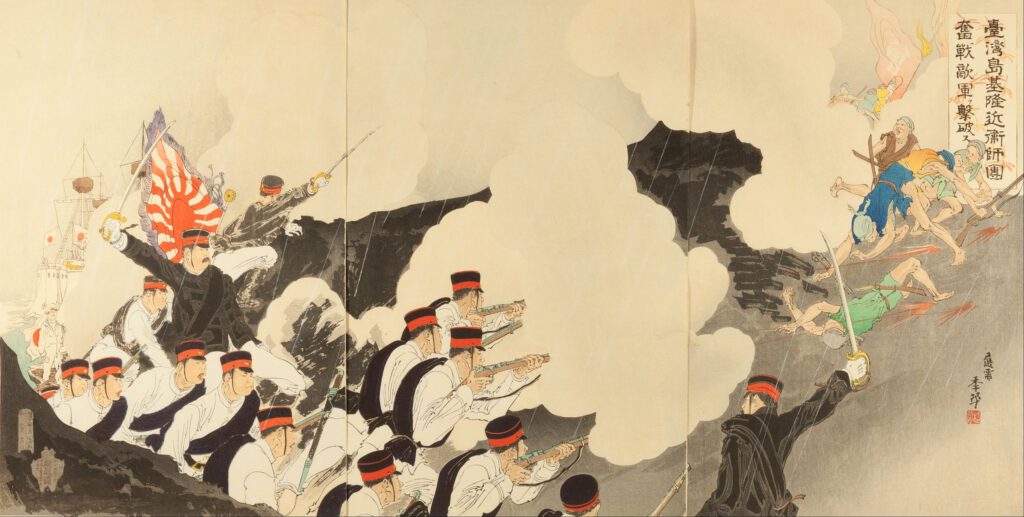The category of Tomari-te is famous in karate circles. For example, there is Tomari Passai in the JKF/WKF syllabus of kata, there is Tomari no Chinto and others in Matsubayashi, there is Tomari no Shirotaru in Yamanni-ryu bojutsu and so on. However, the designations of Shuri-te, Naha-te, and Tomari-te for Okinawa karate are usually quoted without providing a reference. Therefore, today I would like to look into early mentions of Tomari as a place of specific karate technique.
First of all, Funakoshi Gichin mentioned it already in 1913 as follows [Note 1].
▲ The styles of karate
Every now and then people call it Shuri-te, Naha-te, and Tomari-te, as if they existed separately. While there are these people, this fallacy will unravel itself when the real reason of the styles’ origin is clarified. As regards this, since ancient times it [karate] has been divided into two branches called Shōrei-ryū and Shōrin-ryū. The first is a school that places emphasis on the body, and the latter one emphasizes the method [jutsu]. Waishinzan belongs to the former, and Iwā belongs to the latter. Waishinzan is a wild, fat-bodied warrior, and Iwā is a quick-witted, lively, and accomplished man with a slim body. Naha draws from the Shōrei-ryū, and Shuri enters the Shōrin-ryū. Tomari has combined these two things. By becoming the so-called “middle hand”, Tomari-te was made into an individual school.
It is clear from the above text that at that time Funakoshi considered Tomari-te as a mix between Shōrei-ryū and Shōrin-ryū. This is pretty straightforward in that it is proof that the term Tomari-te was known and used by various persons already in 1913. If I would have to take a guess I would say that the suffix te here explicitly referred to kata, but in fact there is no clear proof for that.
Let’s look further back in time. The Conscription Ordinance in Japan was officially proclaimed in 1873. While it was implemented in Okinawa only in 1898, long after the other Japanese prefectures, several Okinawans volunteered to join the Japanese Imperial Army, including persons such as Yabu Kentsū and Hanashiro Chōmo, who later basically constituted the first generation karate teachers in Okinawa.
Another such volunteer was a certain Yagi who originated from Tomari. Yagi was recruited as a volunteer soldier at the Rikugun Kyōdōdan military academy for the training of non-commissioned officers of the Imperial Japanese Army. Under the headline “The Welcome Party for Master Sergeant Yagi,” the local newspaper reported about the circumstances of a welcome party for occupation forced stationed at the Taiwan Garrison — Taiwan belonged to Japan since the end of the 1st Sino-Japanese War in 1895. The soldiers at that time where returning home on their way to re-assignment to the 21st regiment of Hiroshima. I have presented this article previsouly in my out-of-print “Karate 1.0” (2013), but for the convenience of the reader present it here again (Note 2):
On October 15, 1899, Infantry Master Sergeant Yagi returned home from service with the Taiwan occupation forces. On the afternoon of the 18th from three o’clock like-minded persons prepared a welcome party and grand banquet for Master Sergeant Yagi at the Tomari primary school. Setting out from Master Sergeant Yagi’s house, the Tomari primary school staff members and pupils reached the assembly hall in the primary school. The district headman, more than thirty middle school pupils from the section of village, policemen, active service soldiers from Master Sergeant’s older brother’s section of village, and other like-minded persons added up to more than about four hundred persons. The meeting was opened, and everyone saluted the guest of honor on that day, Master Sergeant Yagi. Yagi, participant in the 1st Sino-Japanese War, himself gave a speech and the whole audience was deeply moved. Then the members held speeches, and when they were finished, everybody turned to drinking and the banquet. Then, as an entertainment, the middle school students presented performances such as fencing (gekken) and sword dance (kenbu), and Tomari’s strong point of tōdī (karate). Following the entertainment, Master Sergeant Yagi got up himself and loudly sang a war song of a great victory.
There is a lot you can derive from this. Karate was the strong point or specialty (tokui) of Tomari already in 1899. It was presented at a welcome party for a Master Sergeant Yagi who was native to Tomari. Yagi volunteered to join the Imperial Japanese Army and was a member of the Japanese occupation forces stationed on Taiwan, conquered in the 1st Sino-Japanese War in 1895, in which Yagi has participated. There were thirty middle school pupils from the section of Tomari, policemen, and soldiers in active service. The middle school pupils were pupils at the Middle School in Shuri, which was the only middle school at the time. And they presented fencing (gekken = precursor of kendō), sword dance (kenbu), and karate as a specialty of Tomari.
So what you see here is the context of military, education, and karate already in 1899. Also, it is an example of Okinawan soldiers as members of occupation forces in Asia since the 1890s and no doubt this was the case until 1945, that is, for half a century. This is an important point to keep in mind when it comes to postwar narratives and karate in Okinawa.

Members of the Imperial Japanese Army (left) attack Taiwanese (right).
Source: Wikipedia
Note 1: Shōtō (Funakoshi Gichin): Karate wa Bugei no Kotsuzui nari (Karate is the Bone Marrow of Martial Arts). Ryūkyū Shinpō, January 9, 1913.
Note 2: Yagi Sōchō no Kangeikai (The Welcome Party for Master Sergeant Yagi). In: Ryūkyū Shinpō, Friday, October 21, 1899.
© 2021, Andreas Quast. All rights reserved.
